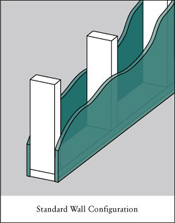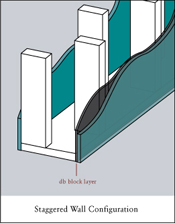Sound Transmission Class
The STC is a single number rating scale that measures a wall, ceiling, or floor assembly’s ability to block sound transmission. The higher the number, the greater the drop in decibel levels bleeding through the surface. A standard interior wall constructed with 5/8″ drywall on hollow studs has an average Sound Transmission Class of 33. A luxury-grade assembly will boast STC values of more than 55- 60. Stronger STC values for new build or existing walls are triggered using the barrier treatments outlined in our course on Transmission Loss here at the Academy, and applied in detail in our Walls, Ceilings and Floor sections of our Applications Guide. These soundproofing treatments target the isolation of a sound wave as depicted here:
Using the STC code is simple math. If one room is producing loud stereo music with levels exceeding 100 decibels, and the dividing surface assembly to the adjoining room held an STC rating of 55, one could reasonably expect the dB level from that music in the adjoining room to carry a reading of 45. In a laboratory setting, this result can be measured in complete isolation. In a field test, this result will decay due to leakage, vibrations, and other sound sources that will combine to alter the results.
Regardless of the field results, remember that decibels are measured on a logarithmic scale (powers of 10). That means for every 3 dB reduction your treatment provides, sound intensity is reduced by 50%. It’s important to note that sound intensity does not equal “perceived sound level”. In fact, a decrease of 3 dB, or cutting the sound intensity in half, is considered barely noticeable to humans. However, a 10 dB reduction is perceived as being half as loud. This means that increasing a wall’s STC rating from 33 to 53 (20 dB) results in a 75% reduction in perceived sound and increasing to an STC 63 (30 dB) results in a 88% reduction in perceived sound transferring through the wall!
The Uniform Building Code assigns a required STC value for multi-dwelling units that include a standard rating for townhomes, condominiums, hotels, and motels. The walls will typically require an STC rating of 50+ when field-tested. Luxury units will boast STC values over 55. In comparison, the standard wall configuration in a residential home illustrated here will carry an average STC rating of 33:

As we outline in our course on Transmission Loss, and illustrate in our Walls section of our Applications Guide, this standard wall configuration can be upgraded with a sound barrier treatment to trigger a much stronger STC value. As sound waves transmit structurally through the common set of studs pictured above, we trigger an increase in the STC rating by disconnecting the common structure and lining the wall with more density. This sound isolation process will force the sound wave to collapse inside the wall. The disconnection comes in the form of a variety of different framing techniques or resilient sound isolation clips used for new or existing walls. The density comes in the form of a thin layer of mass-loaded vinyl called dB-Bloc. This combination illustrated below can trigger STC values of 60+.

To recap, the STC is a rating system that measures an overall wall, ceiling or floor surface’s ability to block and contain unwanted sound transmission. It is also a rating system that is used to measure a product’s ability to block and contain noise. The stronger the rating, the more protection from noise you receive. While products are indeed tested for their STC value in a laboratory, their performance in an actual application can vary depending on vibration potential and air gaps. To improve the STC rating of a common surface, the goal as outlined in our Transmission Loss course here at the Academy is to disconnect the structure and line it with density.
See Wall Treatment See Ceiling Treatment Back to Sound 101